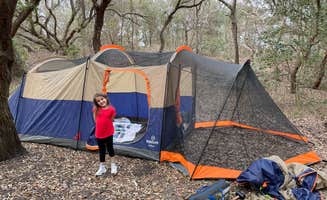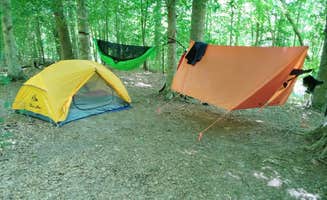Primitive tent campsites near Knotts Island, North Carolina offer visitors access to some of the most isolated beach and swampland camping in the Mid-Atlantic region. The area sits at the northeastern edge of North Carolina where Currituck Sound meets the Atlantic Ocean, with most sites at near sea level elevations. Winter temperatures average 40-50°F with summer highs regularly reaching 85-95°F and high humidity levels from June through September.
What to do
Kayak fishing: The waters around Merchants Millpond State Park provide unique fishing opportunities in a cypress swamp environment. "Tons of wildlife to see. Turtles, gators, snakes. Not a place I'd go in the summer because I'd imagine you'd get carried away by bugs but definitely a place to check out in spring or fall," notes camper Heather R. The park's waters contain unusual species like gar that can be caught from canoes or kayaks.
Beach hiking: Walking the shoreline at False Cape State Park offers opportunities for wildlife spotting and exploration. A camper reports, "We saw dolphins playing in the ocean! The beach alive with crabs! Osprey catching fish!" Sandy hiking trails connect different parts of the park, with historical landmarks including "an old graveyard and church steeple at Wash Woods, that's definitely worth the hike."
Seasonal birding: Fall through spring brings significant bird migrations through the area wetlands and shorelines. Multiple campers mention seeing bald eagles, waterfowl, shorebirds, and raptors. One visitor to Merchants Millpond noted, "We saw a bald eagle's nest, snakes, frogs, turtles, and lily pads everywhere."
What campers like
Isolation from crowds: The remote nature of these sites requires physical effort to reach, limiting visitor numbers. "Because of this, the Park is a serene oasis away from traffic, no RV's, not a lot of people. A great place to get away from it all!" writes Katie M. The multi-mile hikes or paddle trips required to reach most sites create a natural buffer from casual visitors.
Sunrise beach access: Oceanside sites at False Cape provide direct beach access with exceptional sunrise viewing. A camper describes, "Such an amazing experience to wake up to the sun rising over the Atlantic ocean and sleeping under the stars. There were only two other tents camped out on the beach with us when we were there so it was still pretty isolated."
Diverse camping environments: Bennetts Creek Campground at Merchants Millpond offers a different swampland experience with high ground primitive sites accessible by water. "It was a 4.5 mile paddle to the site, then roughly 1.5 down to the dock with a staged vehicle," reports camper Todd B. The park provides multiple tent camping options from backpacking sites to canoe-in locations.
What you should know
Access limitations: Some sites have strict access requirements that must be planned for. At False Cape, "the Park is 5+ miles from the Little Island Park Parking lot, where you have to park if you're staying overnight. So, you have to hike, bike or boat into the primitive campground because its access is blocked by Back Bay Wildlife Refuge." No vehicle access means carrying all supplies in and out.
Water navigation challenges: Sandy Bottom Nature Park offers easier access with "sites located about 1/4 mile from the parking lot down a trail," but water-based camping at Merchants Millpond can be difficult to navigate. "The kayak/canoe round was not easy to navigate so bring your 3rd party map/GPS. The maps they provide are almost useless because it outlines the terrain but because it's a swamp the terrain changes with the water level," warns Mark N.
Seasonal insect conditions: All local tent camping areas report significant insect activity during warmer months. One camper advises about Merchants Millpond, "Not a place I'd go in the summer because I'd imagine you'd get carried away by bugs but definitely a place to check out in spring or fall." The biting insects typically diminish significantly from late October through early April.
Tips for camping with families
Distance considerations: Families should carefully assess hiking distances when choosing tent sites. At False Cape, some campers successfully bring children to remote sites: "We came in mid-June and the weather was gorgeous - 80s during the day and 60s at night. There were some biting flies and mosquitos but nothing a little bug spray couldn't take care of." Using bicycle trailers can help transport younger children and gear.
Wildlife viewing opportunities: Merchants Millpond Backpack Campground provides walk-in tent sites with excellent wildlife viewing for children. Campers report regular sightings of "turtles, gators, snakes" plus various birds and amphibians. The millpond water trails are marked with buoys to help navigation.
Food and water planning: With most sites lacking direct vehicle access, families need careful meal planning. A False Cape camper reports, "We ended up doing most of the cooking and eating at the live oaks site and sleeping and hanging out at the beach since there is no picnic table or anything at the beach site." Bringing collapsible water containers is essential as drinking water access points may be limited.
Tips from RVers
Alternative campsite options: RVs cannot access most primitive tent sites in the area, but Sandy Bottom Nature Park offers RV options near tent camping. "The park has plenty of camping spots and also has some yurts that are available to rent out," notes Brandon W. The park provides a more accessible option with "miles of trails around the lake and through the woods you can follow."




